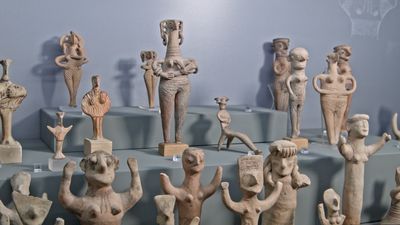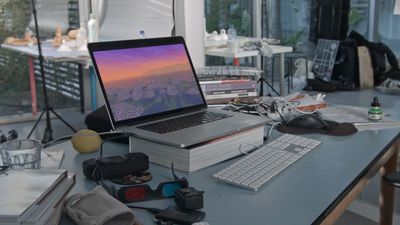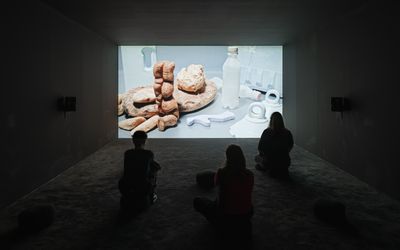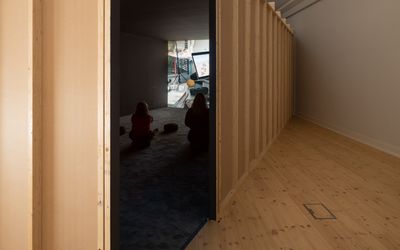Amalie SmithClay Theory
–
–
Amalie Smith’s (1985, DK) exhibition Clay Theory at Kunsthal Aarhus is a meditation on the link between life and clay. It takes the form of a 3D movie presented in Kunsthal Aarhus' Gallery 1, transformed for the occasion into an entirely black room fitted with a soft carpet and meditation mats. In this setting, visitors view the work through active 3D glasses that are switched on and off 120 times per second, alternating between the right and left eye.
The focal point of the film is a group of terracotta figurines: small human figures from the Cypriot Bronze Age, shaped out of reddish-brown fired clay. They can be seen on display at the Cyprus Museum, an archaeological museum in Nicosia, Cyprus. In the film, the terracotta figurines become the centre of a speculative axis that dates all the way back to the origins of life on a barren planet and extends out into a posthuman future where man-made life is a reality. Along the axis between this speculative primordial time and an imagined future, we find clay-based myths of creation emerging in all parts of the world. We also find the story of the Cypriot king Pygmalion, who carved an ivory sculpture so lifelike that she actually came alive. We have golems, homunculi, Frankenstein's monster, cyborgs and androids. It would seem as if humanity has long held a desire for – and fear of – creating life. Perhaps we will be able to do so in the near future. If so, will we look back on the terracotta figurines as precursors of artificial life?
The title itself, Clay Theory, is taken from chemist Graham Cairns-Smith’s theory claiming that life came into being through interaction with clay molecules; a theory also known as the crystals-as-genes hypothesis. The majority of Clay Theory was filmed during a work residency at the Point Centre for Contemporary Art in Cyprus in April 2019. It comprises footage of the terracotta figurines at the museum and as well as footage of various set-ups and experiments in Smith’s studio. Also featured is a rocky landscape on the coast, now the site of discarded plastic waste awaiting the archaeologists of the future. Moreover, a 3D scan of an unborn child, a mother ape and the hand gestures of a robot have found their way into the montage-like film.
The soundtrack features the voices of geologist Minik Rosing, archaeologist Jeanette Varberg and art historian Jacob Wamberg, who have all served as conversation partners in Amalie Smith’s interdisciplinary exploration of how life and clay are connected. The artist is occasionally heard to ask a question: were the clay figurines placed in prehistoric graves regarded as being alive, and did this in turn mean that they could also die? The voices merge with an orchestra of clay flutes playing music by Beethoven, as well as music created by composer Simon Brinck, parts of which was created in collaboration with an artificial intelligence.
3D movies have come and gone several times throughout movie history, but the medium has never achieved real staying power. Each breakthrough has gradually subsided in popularity – the most recent wave of 3D technology found itself replaced by virtual reality. In preparation for her stay in Cyprus, Amalie Smith learned the waning art of filming in 3D and built her own 3D camera in a so-called beam-splitter rig. The resulting piece is Smith’s first 3D film.
Amalie Smith is a graduate from Forfatterskolen (The School of Writing) as well as from the Royal Danish Academy of Fine Arts and continues to work with creative writing and art alike. In Smith’s practice, technology and research merge with art and visual aesthetics. She shows us how prehistory offers a portal that can help us understand not just our present, but our future too. The questions we ask ourselves about modern technology and our perception of life are not necessarily new, even if the technologies involved are. The terracotta sculptures exemplify the alluring and terrifying aspects of this issue because they are potentially either more or less alive than they first appear to be.
Clay Theory is part of the EU-funded project Excavating Contemporary Archaeology, created in collaboration with Point Centre for Contemporary Art (CY), MUCEM (FR) and Air Antwerp (BE).
Credits
Camera, interviews, cut, grading: Amalie Smith
Music and sound: Simon Brinck
Camera assistant: Vasiliki Riala
Camera assistant no. 2: David Stjernholm
Subtitles: Jennifer Russell
Voices speaking:
Minik Rosing, Professor of Geology at the University of Copenhagen
Jacob Wamberg, Professor of Art History at Aarhus University
Jeanette Varberg, Archaeologist and Curator at the National Museum of Denmark
Used with permission:
Adagio del settimino by Ludwig van Beethoven, played by Gruppo Ocarinistico Budriese (IT).
Foraminifera genetics (…) animation and music by Maciej Komosinski (PL) played from framsticks.com
Consultants:
Giorgios C. Paraskeviotis, University of Cyprus (CY)
Mads Rosendahl Thomsen, Aarhus University (DK)
Stjernholm & Co (DK)
Thank you:
Cyprus Museum, Nicosia (CY)
Nicky the Robot and Ali Tayari, Institute For the Future
University of Nicosia (CY)
Pancyprian Gymnasium, Nicosia (CY)
Ultralydsklinikken, Copenhagen (DK)
Andre Zivanari and Maria Mina, Point Center for Contemporary Art (CY)
AIR Antwerp (BE)
NB! Please notice that 3D-film can trigger seizures for light-sensitive individuals.
Supported by







Den Hielmstierne-Rosencroneske Stiftelse





